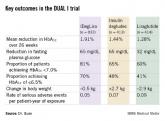SAN FRANCISCO – The fixed-ratio combination of insulin degludec and the glucagonlike peptide-1 receptor agonist liraglutide improved glycemic control with a low risk of hypoglycemia across different weight groups, according to a post-hoc analysis of two phase III trials.
The investigational drug IDegLira also effectively reduced hemoglobin A1c (HbA1c) in both insulin-naive patients and in patients who were previously uncontrolled on basal insulin, Dr. John B. Buse reported at the annual scientific sessions of the American Diabetes Association.
Dr. Buse and his colleagues analyzed the phase III DUAL I and DUAL II trials to find the efficacy and safety of IDegLira across four body mass index (BMI) categories: less than 25 kg/m2; 25-30 kg/m2; 30-35 kg/m2; and more than 35 kg/m2.
DUAL I, a large open-label study of 1,600 insulin-naive patients with type 2 diabetes, compared IDegLira with insulin degludec (IDeg) and with liraglutide (Lira).
The DUAL II trial involved 400 patients and was designed to specifically study the contribution of liraglutide in IDegLira, compared with IDeg alone. Study participants had been on modest doses of insulin and had relatively uncontrolled diabetes.
The analysis showed that there was a consistent and significant HbA1c reduction across all baseline BMI categories in the DUAL I and DUAL II trials.
In DUAL I, IDegLira reduced HbA1c by 1.8%-1.9%. IDeg lowered HbA1c levels between 1.1% and 1.4%, and Lira reduced those levels between 1.1% and 1.3%.
The DUAL II results also showed similar significant reductions when IDegLira was compared with IDeg. "Relatively great efficacy of combination is maintained across the BMI categories," said Dr. Buse, professor of medicine, chief of the division of endocrinology and metabolism, and executive associate dean for clinical research at the University of North Carolina, Chapel Hill.
With IDegLira, there also were low rates of hypoglycemia across the four BMI categories in both trials.
The combination also reduced insulin requirement across BMI categories in DUAL I when IDegLira was compared with IDeg. In DUAL II, the insulin doses were equivalent for IDegLira and IDeg across the BMI categories, since titration was capped at 50 units to achieve identical exposure.
Previous studies on the combination of insulin with GLP-1 agonists have had uniformly encouraging results, showing less weight gain and in some cases better overall glucose control, said Dr. Matthew C. Riddle, professor of medicine at Oregon Health and Science University in Portland, who was not involved in the study.
Combination therapies do have some disadvantages, he said, and "you get potential side effects from GLP-1 agonists that you don’t get from insulin. But overall, the balance looks very favorable. So this is one in a series of studies that shows this is an attractive option for the future."
Dr. Buse is a consultant to Novo Nordisk and more than 30 other pharmaceutical companies. Dr. Riddle said that he is a consultant for several companies, including Novo Nordisk.
nmiller@frontlinemedcom.com
On Twitter @naseemmiller
